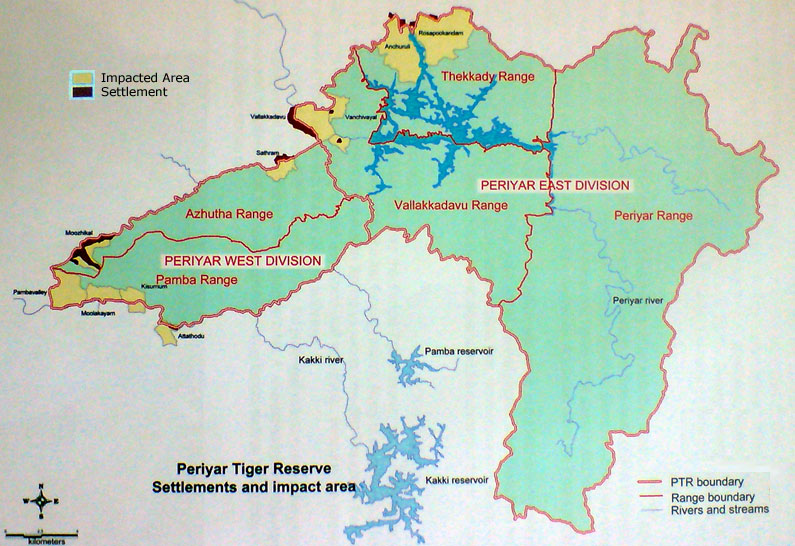Recommendations
 Independent studies indicate that
there are chances of dam breaking in case the water level of the
dam is raised beyond 136 ft. The ecological impact of such an
eventuality will be catastrophic. Easiest way to avoid that will
be to restrict the water level in the reservoir within the present
limit.
Independent studies indicate that
there are chances of dam breaking in case the water level of the
dam is raised beyond 136 ft. The ecological impact of such an
eventuality will be catastrophic. Easiest way to avoid that will
be to restrict the water level in the reservoir within the present
limit.The Committee is concerned to observe that any increase in water level will submerge a greater part of the critical grasslands of the Periyar ecosystem, and this could severely impair the food chain of the endangered tiger whose prey base is the deers depending on the grassland. Such likelihood in a Reserve dedicated to tiger and protected by the Wildlife Protection Act 1972, including its latest amendment should be completely avoided. Additionally, loss of grasslands will also drastically affect the viewing of the animals. While the animals may recreate a foreshore for their convenience in due course, it is likely to take several years. In the meantime, there will be a likelihood of considerable fall in tourist interest, which in turn may significantly reduce the earning of the local people as also the revenue flowing towards protected area management and nature education.
It will be imperative to carry out a detailed EIA (Environmental Impact Assessment), as a statutory requirement to fully understand the ecological impact of raising the water level. The study will have to be on the basis of a. scientific design of research. Substantial information on the ecological impact of raising the water level of the dam on the surrounding ecosystem, including human habitation, is available from the Kerela Forest Research Institute (KFRI).
Signs of distress and fear are visible amongst the tribes people living round the settlement areas comprising six villages. This state of distress in the minds of the settlers, particularly the children, should be separately studied.
Until the completion of the EIA studies, including a comprehensive study of the ecological impact of raising the water level of the reservoir along with a social cost benefit study of the additional expenses that will have to be incurred by way of strengthening of dam and laying of new distributary system for the additional water, all the engineering efforts to raise the water level should be put on hold. This is also because .any large scale prolonged movement of men, material and machinery through a patch of land, which is endowed with a rich biodiversity, is not desirable within a protected area.
.
According to Section 9 of the Wildlife (Protection) Act, 1972 'No person shall destroy, exploit or remove any wild life including forest produce from a sanctuary or destroy or damage or divert the habitat of any wild animal by any act whatsoever or divert, stop or enhance the flow of water into or outside the sanctuary, except under and in accordance with a permit granted by the Chief Wild Life Warden, and no such permit shall be granted unless the State Government being satisfied in consultation with the Board that such removal of wild life from the sanctuary or the change in the flow of water into or outside the sanctuary is necessary for the improvement and , better management of wild life therein, authorizes the issue of such permit.'
The expert team strongly recommends adherence to the provision of this Act in its entirety.
A decision regarding the strengthening of the dam or any new construction that may be suggested will require the involvement of the Forest Department so that measures could be taken to minimise the damage inflicted on the protected eco-system: This is obligatory because the dam lies within a wildlife sanctuary which is now a part of a tiger reserve and also an elephant reserve.
Since 1979, at least six conglomerations of human settlements, predominantly tribal, have come up. Public institutions and commercial establishments have also grown. Raising of water level would mean displacement of a large number of families along with their economic activities. Therefore, the question of allowing additional water to Tamil Nadu will also have to be weighed against the lives and livelihood of these tribal people, since they will be forced to go back into the forest and start exploiting the ecosystem. This will also destroy the benefits accruing from the eco-development projects of the Forest Department over the years.
At present the matters relating to raising of water level are only handled by the Water Resources Department. It will be advisable to set up a coordinating committee headed by the Chief Minister of the State with all the stake-holder departments within its fold. This will allow convergence and best use of .all the related views and expertise to ensure the ecological security of the natural resource system in question as well as the protection of life and livelihood of the people which is likely to be threatened in case of any deviation from the present state of protected area management.
Dr Dhrubajyoti Ghosh
Dr H.SA Yahya
Shri S. K. Patnaik
June 2007
Dr H.SA Yahya
Shri S. K. Patnaik
June 2007

